A year exploring ways to secure Waiapu Cathedral’s future has provided just one viable option for the building says Di Woods, the Cathedral’s Dean.
Repurpose and save
Repurposing part of Napier’s iconic but earthquake-prone Art Deco Anglican cathedral for commercial use is likely, she told parishioner’s last Sunday.
A developer’s concept drawings could see the current nave converted into four storeys of commercial space (500m2 per floor), with the rest retained for church use, Woods said.
That option has support from the building owners, Waiapu Cathedral Board of Diocesan Trustees.
They have “resolved in principle to support the repurposing of the Cathedral for commercial use, and are open to joint venture proposals” Woods said.
She went on to reassure parishioners that their future during the repurposing works is also being considered.
“For our Cathedral parish people, the positive options include temporary relocation to another church or hall for worship services, and the possibility of merging with other parishes into a Greater Napier parish” Woods said.
What’s behind the plan?
In common with many heritage building owners, Waiapu Cathedral’s Vestry and Seismic Strengthening Committee had some hard decisions to make about the building’s future.
“We have no intention of demolishing the building – the reasons include cost, heritage awareness, public sentiment and risk, with uncertainty about what lies beneath our foundations” Woods wrote is a letter to the parish.
She explained the parish has no ability to strengthen the Cathedral in its current form.
“We cannot afford to do so, and the modifications necessary to make it useful for the wider community only escalate the cost, as does the NCC District Plan’s proposal of a tier 1 heritage listing.”
Woods also told parishioners that the committee has “no appetite to strengthen [the Cathedral] – our financial situation in 2024 sees us unable to meet the costs of operating the existing building, which means strengthening ‘as is’ becomes futile”.
Source
